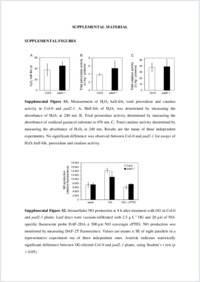Glutathione deficiency of the Arabidopsis mutant pad2-1 affects oxidative stress-related events, defense gene expression, and the hypersensitive response
- Dubreuil-Maurizi, Carole Université de Bourgogne, UMR Plante Microbe Environnement, Dijon, France
- Vitecek, Jan Université de Bourgogne, UMR Plante Microbe Environnement, Dijon, France - Institute of Biophysics, Academy of Sciences of the Czech Republic, Brno, Czech Republic
- Marty, Laurent Heidelberg Institute for Plant Science, Heidelberg University, Germany
- Branciard, Lorelise Department of Biology, University of Fribourg, Switzerland
- Frettinger, Patrick Université de Bourgogne, UMR Plante Microbe Environnement, Dijon, France
- Wendehenne, David Université de Bourgogne, UMR Plante Microbe Environnement, Dijon, France
- Meyer, Andreas J. Institute of Biophysics, Academy of Sciences of the Czech Republic, Brno, Czech Republic - Heidelberg Institute for Plant Science, Heidelberg University, Germany
- Mauch, Felix Department of Biology, University of Fribourg, Switzerland
- Poinssot, Benoît Université de Bourgogne, UMR Plante Microbe Environnement, Dijon, France
-
17.10.2011
Published in:
- Plant Physiology. - 2011, vol. 157, no. 4, p. 2000-2012
English
The Arabidopsis (Arabidopsis thaliana) phytoalexin-deficient mutant pad2-1 displays enhanced susceptibility to a broad range of pathogens and herbivorous insects that correlates with deficiencies in the production of camalexin, indole glucosinolates, and salicylic acid (SA). The pad2-1 mutation is localized in the GLUTAMATE-CYSTEINE LIGASE (GCL) gene encoding the first enzyme of glutathione biosynthesis. While pad2-1 glutathione deficiency is not caused by a decrease in GCL transcripts, analysis of GCL protein level revealed that pad2-1 plants contained only 48% of the wild-type protein amount. In contrast to the wild type, the oxidized form of GCL was dominant in pad2-1, suggesting a distinct redox environment. This finding was corroborated by the expression of GRX1-roGFP2, showing that the cytosolic glutathione redox potential was significantly less negative in pad2-1. Analysis of oxidative stress-related gene expression showed a higher transcript accumulation in pad2-1 of GLUTATHIONE REDUCTASE, GLUTATHIONE-S-TRANSFERASE, and RESPIRATORY BURST OXIDASE HOMOLOG D in response to the oomycete Phytophthora brassicae. Interestingly, oligogalacturonide elicitation in pad2-1 revealed a lower plasma membrane depolarization that was found to act upstream of an impaired hydrogen peroxide production. This impaired hydrogen peroxide production was also observed during pathogen infection and correlated with a reduced hypersensitive response in pad2-1. In addition, a lack of pathogen-triggered expression of the ISOCHORISMATE SYNTHASE1 gene, coding for the SA-biosynthetic enzyme isochorismate synthase, was identified as the cause of the SA deficiency in pad2-1. Together, our results indicate that the pad2-1 mutation is related to a decrease in GCL protein and that the resulting glutathione deficiency negatively affects important processes of disease resistance.
- Faculty
- Faculté des sciences et de médecine
- Department
- Département de Biologie
- Language
-
- English
- Classification
- Biological sciences
- Other electronic version
- License
-
License undefined
- Identifiers
-
- RERO DOC 28648
- Persistent URL
- https://folia.unifr.ch/unifr/documents/302358
Other files
Statistics
Document views: 101
File downloads:
- pdf: 208
- Supplementary material: 129

